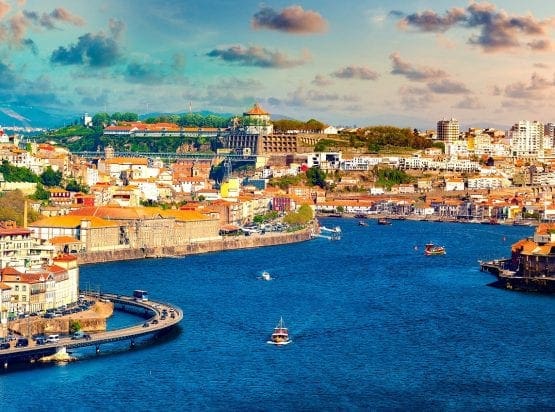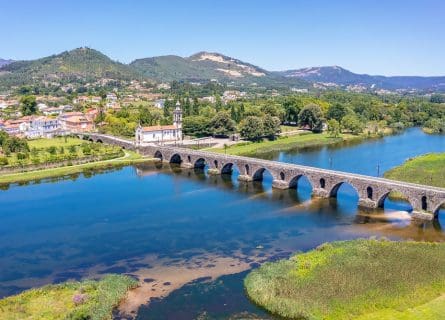Uncover Oporto's vibrant flavors and culinary gems with our expert guides. Plan an unforgettable trip now!
Read more
EXPLORE ALL OUR GUIDES TO PORTUGAL'S WINE REGIONS
Last updated: January 4, 2024
Vinho Verde is produced in the heartland of Portugal’s wettest vineyard, the Minho, so you’d expect something a bit – well, tart and crisp. Vinho Verde does not disappoint: some of Portugal’s liveliest wines are made here, packed with ripe acidity and crunchy fruit. If you seek bags of alcohol and rich concentration, look elsewhere. Yet in the 20th century, when critics – and consumers – became fixated on strong flavors and wines with muscular potency, Vinho Verde was in danger of becoming an anachronism.
But after years of neglect and decline, this beautiful region is back in vogue. The growing movement to embrace moderation (and lighter wine styles) has come at an opportune moment for the Minho; this is one of the few destinations in Portugal where relatively low alcohol can be easily obtained. Sommeliers have been banging this drum for years – consumers desire lighter, fresher, and more elegant wines, they claim. We’d have to agree based on rising exports and investment into the Minho.
The vineyards of the Minho, situated between the Douro River and the Spanish border, have been cultivated since ancient times. Historians are certain that the Romans, who subjugated northern Portugal in the 2nd century BC, were particularly fond of the tart, green wines of Vinho Verde. Indeed, after establishing a settlement called Bracara (modern-day Braga) in 20 BC, the area under vine expanded considerably. In addition, the Roman philosophers Lucius Annaeus and Pliny the Elder referenced the wines of the Minho. At the same time, records dating back to the 9th century indicate that religious orders took over wine growing at a convent in the region.
However, the preceding centuries were a time of immense political and social turmoil. After the Roman Empire collapsed in 476 AD, large swathes of Western Europe were fought over by rival civilizations seeking to fill the power vacuum. The Suebi eventually controlled Northern Portugal, who sent their mighty armies to conquer neighboring Galicia and Asturias. Yet the fight was not over: ‘Galeicia’ was seized by the Visigothic king Theodoric III in 584. Establishing a permanent base in the handsome city of Toledo, the Visigoths had bold plans to conquer the entire Iberian Peninsula.
Unfortunately, the Visigoths weren’t the only ones to claim Hispania. In 711, the Muslim leader Tariq led a force of Moors and Berbers into Andalucia. The Visigoths could not hope to repel such a disciplined (and large) army; within a few years, the Moorish flag flew over much of Spain and Portugal. And yet, the story was far from over. Alfonso III ejected the Moors from northern Spain in the 8th century – the Minho soon followed. By the 1200s, a thriving wine industry was at the heart of the region’s economy, with Vinho Verde wines sent to England, Germany, and Holland. The entire landscape was covered in vines from head to toe.
Portuguese sailors, meanwhile, had started to explore the New World. They returned from Brazil with many exotic foodstuffs, not least the (now) ubiquitous maize crop. Regulations soon decreed that maize should be planted instead of vines in the Minho, which left winegrowers in a dilemma. As a result, vines were trained on trees and hedges, while the land underneath was given over to growing corn. You can still see examples of this old-fashioned method of training vines, although the critical mass use pergolas.
If you stand in a vineyard in the Minho today, gazing at the Atlantic, the prevailing mood is serene tranquility. Nevertheless, change is sweeping through this corner of northern Portugal, as rising demand encourages new plantings and the quest for higher quality.

Vinho Verde is made in the country’s northernmost province, sandwiched between the Douro and Minho Rivers. It’s a prime piece of real estate, flanked by the Atlantic to the west and Galicia to the north. It is also Portugal’s most beautiful region, a lush and verdant landscape rich in diverse flora and fauna. It could be described as paradise, although high rainfall (over 1,600mm per year) and fierce Atlantic winds can spoil things in the spring and fall. Indeed, the overall climate is decidedly maritime. So the biggest viticultural risk is simply overproduction: coastal vineyards receive the most rain, potentially leading to inflated vine canopies and dilute, aggressively tart wine. Fungal diseases are another omnipresent headache in wetter zones.
For that reason, altitude and proximity to the ocean will determine grape choices and their results in the subregions of this vast area. For example, the northernmost subzones of Monção and Melgaço are sheltered from the Atlantic by a chain of hills. This creates a relatively dry and warm mesoclimate, albeit the nights are still very cool due to the elevation.
The range of soils is no less diverse. They include shallow, sandy terroir, granite, and schist. In addition, many of the vineyards are surrounded by dense woodland, which encourages biodiversity and natural pest control via birds.
There is a stubborn myth that all Vinho Verde is produced in a white style; the term ‘Verde’ refers to the young age of the wine, as opposed to maduro or aged. But while it’s true that over 70% of vineyards (approximately 21,000 hectares) are planted to white varieties, the Minho is a multi-color region. Vinho Verde is Portugal’s biggest DOC (Denominação de Origem Controlada). The designation can be used for red, white, and rosé wines and a small volume of exceptional fizz. Homogeneous, it is not.
And yet, Vinho Verde is still pigeonholed as ‘light and crisp,’ often with less than 11% alcohol. However, this is half the truth. Indeed, many white and red Vinho Verde is designed to be drunk young – poor winemakers use sugar to mask the sometimes excessive acid line. However, most producers do not use oak at any stage in the winemaking process, bottling their wines relatively soon after the harvest. Typically, they are fermented in stainless steel or concrete, with a short maceration for the reds. Occasionally, very ripe wines (by local standards) may be subject to a spell in wood. But this is seldom a good idea – oak can spoil the fruity exuberance of Vinho Verde.
Vinho Verde is in a state of flux. In the 1900s, there was a willing (and uncritical) audience for the most basic, thinnest Vinho Verde wines; reds are still served in tea cups in the region’s atmospheric local taverns. A glass could be yours for under 50 cents. However, the demand for acidic plonk has shrunk dramatically recently while a new generation of growers has decided to embrace quality. Moreover, as Vinho Verde producers prioritize export markets, the production of white wines has soared. The local Vinhão grape, meanwhile, is increasingly used to make delicious rosé: wonderfully fresh and pungently aromatic. There is, of course, still a domestic market for the tart, astringent red wines that used to dominate production in the inclement climate of the Minho, but it is declining.
Yet single-varietal expressions, once considered almost sacrilegious, are becoming more common. Historically, white Vinho Verde was made from a blend of grapes, including Loureiro, Arinto, Alvarinho, and Trajadura. The result typically boasted an alcohol level of about 10% – in weak vintages, nine percent was considered reasonable. As a result, blending was a vital insurance policy in case one (or more) varieties failed to ripen. However, global warming has left its indelible mark on the region, and today’s wines are more balanced and fruity; alcohol levels of 12.5% are seen as perfectly obtainable. This partly explains the growth in single-varietal Vinho Verde, often made from the region’s celebrity grape Alvarinho. So too, are Loureiro and the citrussy Arinto being used to fashion contemporary standalone wines.
Once upon a time, mixing and matching different grape varieties was a necessity in the damp hills of the Minho. However, that is no longer the case. Nevertheless, oenophiles rejoice: the wines have retained their saline freshness and seductive balance despite the inevitable effects of climate change. For that reason, Vinho Verde’s popularity is on an upward curve.
Savor the Essence of Albariño: Northwest Spain's Delightful White Grape for Seafood Pairings. Explore the Lightness and High Acidity of this Galician Gem.
Find out moreArinto is a versatile white wine grape variety known for its crisp acidity, citrus, green apple flavors, and a mineral finish
Find out moreExplore the captivating world of the Loureiro grape. Discover its aromatic charm, origins, and the remarkable wines it produces.
Find out moreLearn about the Trajadura grape and its characteristics, including flavor notes, wine styles, and regions where it's grown. Discover the versatility of this Portuguese variety.
Find out moreA rare Portuguese variety known for producing complex, full-bodied wines with dark fruit flavors and firm tannins
A red grape variety often used in Vinho Verde blends, with fresh acidity and berry flavors
Native to Vinho Verde and is known for its aromatic profile, high acidity, and citrus flavors
Rabo de Ovelha produces full-bodied, aromatic wines with tropical fruit, apricot, and honey flavors. This rare grape is known for its high sugar content and is often used in sweet wine production. Despite its name, which translates to "sheep's tail," Rabo de Ovelha produces elegant and complex wines that pair well with desserts, cheeses, and spicy dishes.
Discover Sezão, the dark-skinned Portuguese grape used in port and table wines, boasting rich flavors and a captivating history. 🍇🍷
Find out moreNo prizes for guessing the culinary delicacies you’ll encounter in this part of the world! Chefs and gastronomes wisely eschew imported ingredients for the plentiful bounty that the Atlantic provides, most famously cod and shellfish, including prawns, langoustines, and scallops. Local restaurants base their reputation on the freshness and quality of their bacalhau, prepared in various ways that range from ingenious to staunchly traditional. But vegetables get a proper look-in, too, thanks to the region’s abundant market gardens and rich fertile soils. Caldo Verde is a must-try dish: a rich soup of kale and potatoes. The perfect winter warmer.
If you would like us to customize an exclusive luxury tour, contact us and let us know your travel plans. We offer luxury food and wine tours for private groups of a mininium two guests. In addition, all of our private, chauffeured tours are available year-round upon request.

